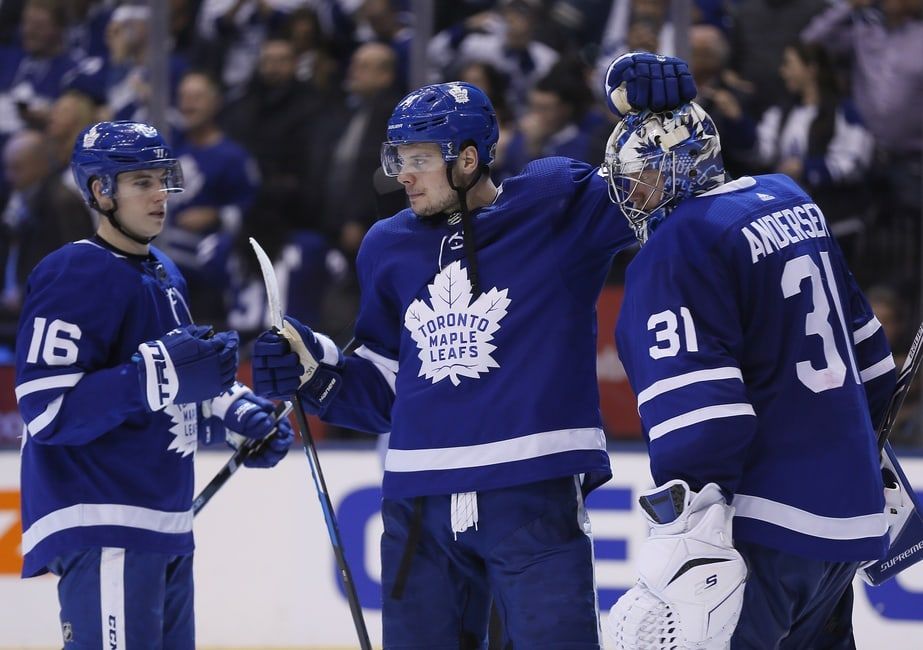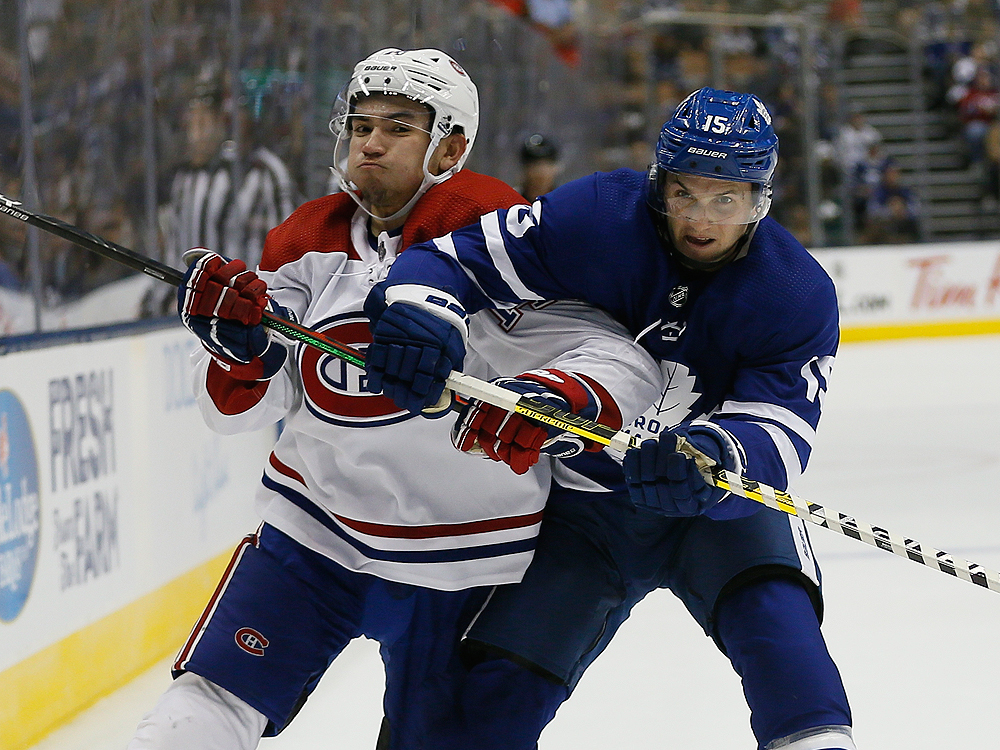In Part 1 of my training camp series, we addressed the following questions:
- Who will flank Auston Matthews (and by process of elimination, Tavares after that)?
- How do Morgan Rielly and TJ Brodie look together?
- Who wins the final two spots on the Leafs defense?
- How will the top prospects be managed?
- Who are the third and fourth line centers?
Well my line predictions were wrong to start (though I think they will play out like that over time). Their true bottom six is kind of mediocre to be honest, so it sounds like they are trying to spread out the forwards a bit to mitigate that.
— Anthony Petrielli (@APetrielli) January 3, 2021
Now, let’s get into the final five questions facing the Leafs heading into training camp and the start of the 2021 regular season.
6. Who rounds out the bottom six at forward?
I’d argue the Leafs‘ bottom six hasn’t received enough attention if we look at the options at the team’s disposal (and what they are likely capable of producing in 2021).
They aren’t particularly stout defensively or explosive offensively, and they lack speed (Pierre Engvall and Robertson are fast, but I am guessing they enter camp on the outside looking in). If Ilya Mikheyev rounds out the top six – which is absolutely not a guarantee – the rest of the forward group is Joe Thornton, Wayne Simmonds, Alexander Kerfoot, Jimmy Vesey, Jason Spezza, Joey Anderson, Alexander Barabanov, Travis Boyd, Pierre Engvall, and Nick Robertson.
The team has to pick six from there. Thornton, Kerfoot, and Simmonds are obvious starters. It’s plausible — even likely — that Thornton and Simmonds are given some breaks throughout the season to preserve them for the playoffs. Jason Spezza will likely be in this boat as well. That really leaves Vesey, Anderson, Barbanov, Boyd, Engvall, and Robertson competing for two-to-three spots.
Engvall showed quite well on the penalty kill last year, so that might give him a leg up on the others in certain spots, while Vesey has some level of experience and success in the league but struggled last season. The organization seems excited about the addition, but he’s turning 28 in May — he likely is what he is at this point (a depth scorer at best). Barabanov is a wildcard, as is Robertson at this point.
My best early guess at this point would be, in no particular order: Thornton, Kerfoot, Simmonds, Spezza, Vesey, and one of Engvall/Anderson.
7. Who makes up the penalty-killing units?
The main penalty killers for the Leafs last season, particularly in the playoffs, were Jake Muzzin, Justin Holl, Morgan Rielly, and Cody Ceci, as well as Martin Marincin whenever he played. At forward, it was Mitch Marner, Zach Hyman, Ilya Mikheyev when healthy (and even a bit in the playoffs), Kasperi Kapanen, and Alex Kerfoot, as well as quite a bit of ice time for Pierre Engvall and Trevor Moore when the latter was on the team.
Now, the Leafs basically have all these players returning save for Kapanen. They can easily build two units consisting of Marner, Hyman, Mikheyev, and Kerfoot, and call it a day. I’m also inclined to think that if Engvall has a good camp, he should get a further look on the penalty kill because his speed and reach cause serious issues for opposing power plays.
Joey Anderson played nearly two minutes per game on the penalty kill for the Devils last season when he played, while Vesey played nearly a minute per game there. If Anderson has a good camp, I’d guess he’ll play on the penalty kill when/if he plays games, but generally speaking, I don’t think they’ll shake it up too much at forward on the penalty kill.
On defense, the Leafs will need to replace Cody Ceci’s minutes, and TJ Brodie makes sense there. I’ll also be interested to see if they look to save Rielly’s minutes for 5v5 and the power play, perhaps giving shorthanded time to Dermott or Zach Bogosian whenever he plays. Preserving Rielly for those minutes would make a ton of sense, in theory.
8. How do the power-play units shake out (and how are they deployed)?
When Sheldon Keefe took over and loaded up the top power-play unit, the Leafs enjoyed the second most productive man-advantage unit through the rest of the season.
While that sounds great, they benefitted greatly from a big run after Babcock was fired, and they were a middle-of-the-pack power play (14th) from January 1 onward. The unit consisted of Auston Matthews, Mitch Marner, John Tavares, William Nylander, and Tyson Barrie.

I’d be surprised if they mixed up the units the way Babcock did, so I’d guess that Rielly will slide in on the top unit. The bigger question is whether the full-two-minute power plays for the top unit will continue.
Wayne Simmonds has always made his money on the power play (he struggles at 5v5, if anything). Is he going to sit on the bench for one minute and 45 seconds of each power play? Is Joe Thornton? Will Mikheyev get a long look there? Hyman? Kerfoot? There is a time and a place to load up the top guns, but if they plan to do it all season, I think you risk alienating the rest of the roster a little bit and lose out on empowering other offensive players to score and contribute.
It will also be interesting to see who will quarterback the second power-play unit. The Leafs have a number of defensemen that could in theory, but no real slam-dunk option: Jake Muzzin, TJ Brodie, and Travis Dermott have all quarterbacked second units, to varying levels of success, and there is also Rasmus Sandin. This could be the biggest opportunity for Lehtonen to crack the team and make a notable impact.
At forward, it would be shocking to see Thornton and Simmonds not there. From there, we could take our pick of almost any player. I’d guess Mikheyev is there, and the last spot is wide open.
9. Style of play changes
We saw the Leafs adopt a number of changes under Sheldon Keefe: Pulling a forward high in the offensive zone up to the blue line to create offense, a lot more regrouping in the neutral zone, and opening it up a bit more off the rush, to name a few.
Keefe also loaded up top players with ice time — at 5v5 and with power-play time — and played them all together (I’d argue these were done to varied results and often hurt them as much as they helped them).
Now, with a full training camp for Keefe to get things in order and presumably a bit more comfortable and familiar in the role in general, what other kinds of changes will we see? I won’t speculate too much here, but I’ll take notes and outline them as they unfold in front of us this season.
10. Will Frederik Andersen rebound?
At the end of the day, this may be the biggest question as it pertains to the Leafs’ 2021 outlook.
Andersen struggled in the 2019-20 regular season, posting the worst save percentage of his career and consequently giving up the most goals per game of his career. At one point, there was serious debate as to whether Andersen or backup Jack Campbell should start games with the Leafs in a playoff race. And this wasn’t only radio fodder – it was a legitimate question to ask.
In the playoffs, Andersen was generally solid, but he has had a habit of letting in bad goals in big games, and the pattern held true again versus Columbus. This season, at least the Leafs have real insurance should he struggle in Campbell and possibly even Aaron Dell, but really, Andersen needs to step up.
The Leafs might survive an average Andersen in the regular season (or even slightly below average), but they will absolutely need him at his best for the playoffs if they want to go deep.

































